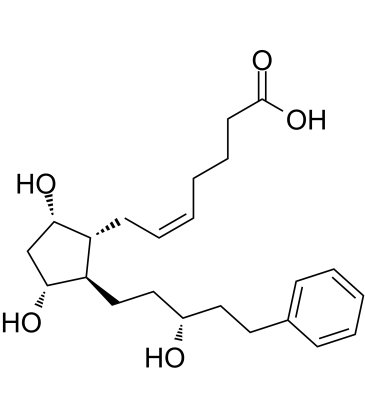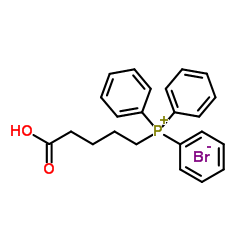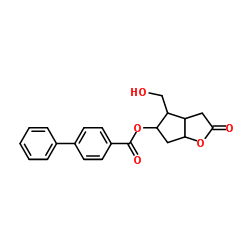LatanoprostAcid

LatanoprostAcid structure
|
Common Name | LatanoprostAcid | ||
|---|---|---|---|---|
| CAS Number | 41639-83-2 | Molecular Weight | 390.513 | |
| Density | 1.2±0.1 g/cm3 | Boiling Point | 609.1±50.0 °C at 760 mmHg | |
| Molecular Formula | C23H34O5 | Melting Point | N/A | |
| MSDS | Chinese USA | Flash Point | 336.2±26.6 °C | |
Use of LatanoprostAcidLatanoprost acid, an analog of prostaglandin (PG) F2α, is an selective prostanoid receptor (FP) agonist that specifically activates the FP-PG receptor[1]. Latanoprost acid inhibits RANKL-induced osteoclastgenesis and function by inhibiting ERK, AKT, JNK, and p38 cascade, following by the c-fos/NFATc1 pathway. Latanoprost acid is a medication which works to lower pressure inside the eyes[2]. |
| Name | latanoprost free acid |
|---|---|
| Synonym | More Synonyms |
| Description | Latanoprost acid, an analog of prostaglandin (PG) F2α, is an selective prostanoid receptor (FP) agonist that specifically activates the FP-PG receptor[1]. Latanoprost acid inhibits RANKL-induced osteoclastgenesis and function by inhibiting ERK, AKT, JNK, and p38 cascade, following by the c-fos/NFATc1 pathway. Latanoprost acid is a medication which works to lower pressure inside the eyes[2]. |
|---|---|
| Related Catalog | |
| Target |
FP |
| In Vitro | Latanoprost acid (10-20 μM;24 hours) reduces he protein expressions of c-fos and NFATc1[1]. Latanoprost acid (10μM with 50ng/ml RANKL) significantly inhibits ERK, p38, AKT and JNK[1]. Latanoprost acid (10 μM, 20 μM) significantly inhibits the mature osteoclast formation[1]. Western Blot Analysis[1] Cell Line: Bone marrow-derived macrophages cells (BMMs) Concentration: 10 μM, 20 μM Incubation Time: 24 hours Result: Reduced he protein expressions of c-fos and NFATc1. |
| In Vivo | Latanoprost acid (i.p.; 20 mg/kg; once a day for 7 days) notably prevents LPS-induced bone destruction at a dose of 20mg/kg[1]. Animal Model: 8-week-old C57BL/6J mice[1] Dosage: 20 mg/kg Administration: Intraperitoneally injected; once a day for 7 days Result: Notably prevented LPS-induced bone destruction at a dose of 20mg/kg. |
| References |
| Density | 1.2±0.1 g/cm3 |
|---|---|
| Boiling Point | 609.1±50.0 °C at 760 mmHg |
| Molecular Formula | C23H34O5 |
| Molecular Weight | 390.513 |
| Flash Point | 336.2±26.6 °C |
| Exact Mass | 390.240631 |
| PSA | 97.99000 |
| LogP | 2.22 |
| Vapour Pressure | 0.0±1.8 mmHg at 25°C |
| Index of Refraction | 1.564 |
| Storage condition | -20°C |
| Personal Protective Equipment | Eyeshields;Gloves |
|---|---|
| RIDADR | NONH for all modes of transport |
| Precursor 7 | |
|---|---|
| DownStream 2 | |
|
New prostaglandin analog formulation for glaucoma treatment containing cyclodextrins for improved stability, solubility and ocular tolerance.
Eur. J. Pharm. Biopharm. 95 , 203-14, (2015) Latanoprost is a practically insoluble prostaglandin F2α analog considered a first-line agent for glaucoma treatment. From a pharmaceutical point of view, latanoprost is challenging to be formulated a... |
|
|
Effect of prostaglandins A(2), E(1), F(2 alpha)and latanoprost on cultured human iridal melanocytes.
Exp. Eye Res. 70(1) , 113-20, (2000) The effect of various prostaglandins on the growth, melanogenesis and dendrification of cultured iridal melanocytes were studied. Iridal melanocytes were isolated and cultured with medium supplemented... |
|
|
Prostaglandins increase matrix metalloproteinase release from human ciliary smooth muscle cells.
Invest. Ophthalmol. Vis. Sci. 38(13) , 2772-80, (1997) To identify matrix metalloproteinases (MMPs) released by ciliary smooth muscle cells in vitro and to determine whether MMP release is altered by exposure to prostaglandins (PGs).Human ciliary smooth m... |
| (5Z)-7-{(1R,2R,3R,5S)-3,5-Dihydroxy-2-[(3R)-3-hydroxy-5-phenylpentyl]cyclopentyl}hept-5-enoic acid |
| Latanoprost acid |
| latanoprost free acid |
| 5-Heptenoic acid, 7-[(1R,2R,3R,5S)-3,5-dihydroxy-2-[(3R)-3-hydroxy-5-phenylpentyl]cyclopentyl]-, (5Z)- |
| LatanoprostAcid |
| (5Z)-7-{(1R,2R,3R,5S)-3,5-Dihydroxy-2-[(3R)-3-hydroxy-5-phenylpentyl]cyclopentyl}-5-heptenoic acid |
 CAS#:130209-82-4
CAS#:130209-82-4 CAS#:17814-85-6
CAS#:17814-85-6 CAS#:352276-28-9
CAS#:352276-28-9 CAS#:31752-99-5
CAS#:31752-99-5 CAS#:100-39-0
CAS#:100-39-0![[1,1'-Biphenyl]-4-carboxylic acid (3aR,4R,5R,6aS)-hexahydro-2-oxo-4-[(1E)-3-oxo-5-phenyl-1-pentenyl]-2H-cyclopenta[b]furan-5-yl ester Structure](https://image.chemsrc.com/caspic/473/41639-72-9.png) CAS#:41639-72-9
CAS#:41639-72-9![(1S,5R,6R,7R)-6-[(3S)-3-hydroxy-5-phenyl-1-pentenyl]-7-[(4-phenylbenzoyl)oxy]-2-oxabicyclo[3.3.0]octan-3-one Structure](https://image.chemsrc.com/caspic/470/41639-23-0.png) CAS#:41639-23-0
CAS#:41639-23-0 CAS#:1088434-86-9
CAS#:1088434-86-9